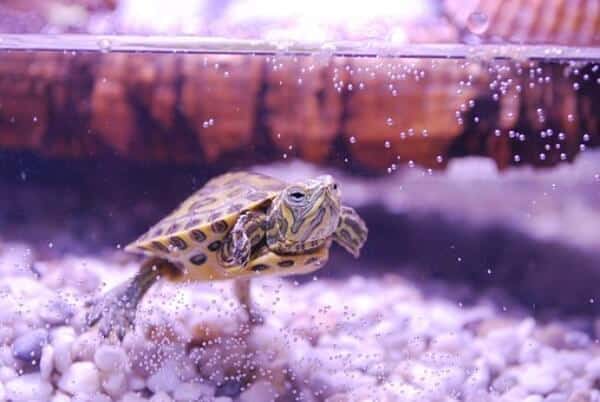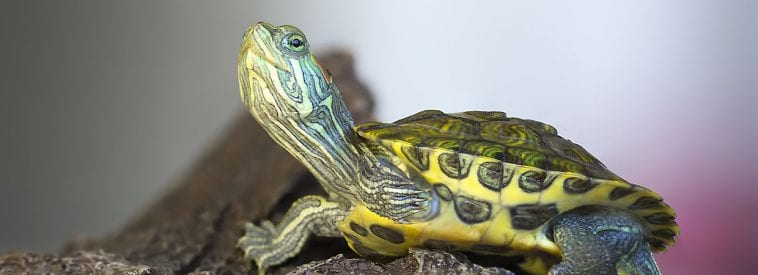Turtles can live for many years or even decades, so you should be willing to take good care of them for a long time. Good hygiene, proper housing, and nutrition can help keep your turtles healthy and happy. Some species have specific care requirements, so ask the pet store or breeder about it.
A well-maintained environment is important for their growth. Since they spend a lot of time in the water, they need an environment with water and a place where they can bask. Here are the secrets to having healthy turtles.
How to Feed Turtles

Buy food that’s made for the turtle species you’re taking care of. Most turtles need vegetables and animal protein. You can buy canned turtle food or pellets at pet supply stores. Aside from high-quality turtle food, you have to supplement your pet’s diet with invertebrates, vegetables, and fish to keep them healthy.
You can give them live and frozen minnows or guppies, crickets, worms, and grasshoppers. Turtles can eat chopped vegetables like lettuce, kale, carrots, and dandelion. Live insects and fish can stimulate their mind.
Swap up their food to keep their meals interesting. For instance, you can give them homemade meals one to two times a week and store-bought food another one to two times a week. Cutting up vegetables into bite-size pieces will prevent choking. Chopped veggies should be smaller than the beak of the turtles.
How often should you feed them?
Turtles should be fed three to four times a week. Most species should be given food every other day. If you want to make sure that you’re doing it right, you should ask the pet store or breeder about how often you should feed the turtle. You can feed them in the morning since they are more active during this time.
How much should you give them?
Turtles should be given food that they can finish within five minutes. Observe the turtles when you feed them to determine how much you should give them. Turtles are likely to overeat if they have a constant supply of food.
If you’re raising box turtles, serve their meals in a food bowl and remove it after five minutes. As for aquatic turtles, you should put their food in the water. Otherwise, they won’t be able to swallow it. Remove extra food after five minutes.
You should also add a pinch of calcium to their meals every other feeding. Calcium keeps their shell strong. Powdered calcium carbonate is available at local and online pet stores. Add calcium to their meals one to two times per week to make sure that they’re getting enough calcium. If you have aquatic turtles, you can throw a chunk of calcium carbonate into the water.
How to Set Up the Housing

Put the turtles in a large enclosure. The volume of the enclosure should be 10 US gallons per 1 inch of the shell length of your turtle. The space requirement of your pet depends on its species. If you own juvenile turtles, you should determine how large they will be when they become an adult.
Make sure that the tank has a cover to prevent the turtles from escaping. If you have aquatic turtles, the depth of the water should be twice the length of the turtle. The bottom of the enclosure should be covered with soil or peat moss.
Combine equal parts of soil and sand or wood chips as well as peat moss. Line the base of the enclosure with 2 to 3 inches of this mixture. Don’t cover the bottom of the enclosure with gravel because the turtles might eat the rocks and choke.
Basking Area
It is also important to create a basking spot for your turtles. One side of the enclosure should have a higher layer of the mixture you made. Place some driftwood or smooth river rocks in this area. This elevated side must stay dry at all times. The river rocks and peat moss slope should not be too steep for the turtles to climb.
You should also place a hiding box in the basking spot, so your turtles can have a comfortable place to hide. If you have aquatic turtles, the height of the basking area should be more than twice the length of the turtle to make sure that it will be above water.
Water
You can use tap water as long as its chlorine level is low. The water level for box turtles must be shallow enough that they can lift their chin above the surface when they are submerged to prevent them from drowning.
Chlorine test kits are available at home improvement stores as well as online and local pet supply stores. If the chlorine level of tap water is above 0, you should buy a dechlorinating agent or add bottled water to the tank.
Heating
Reptile lamps can be used to heat the basking area. You have to create a temperature gradient that has a cool side and a hot side in order to raise the turtles properly. The reptile lamp should have a reflector. The temperature in the basking area should be between 29°C and 32°C or 85°F and 90°F.
You can also use a UVB or UVA fluorescent lamp. UV light provides turtles with vitamin D, which improves calcium absorption. Set up the enclosure 2 weeks before buying a turtle so that you can create the perfect environmental conditions and temperature.
You can also install a filter to maintain the cleanliness of the water. Get a filter that’s labeled for the volume of water in your tank. You can also ask one of the pet supply store employees for advice about buying a filter. Use a net to remove debris and feces from the enclosure daily. You may want to feed the turtles in a separate tank to maintain the cleanliness of the water in the main tank.
Buying a back-up tank is also a good idea. You can use it to transport the turtles. The backup tank will be used temporarily, so you don’t need to buy a large one. Just make sure that the turtles have some space to crawl around. Put the heat lamp in the back-up tank when you’re using it.
How to Keep Turtles Healthy
Video Source: Youtube
You should inspect your turtles every one or two days to check for signs of illnesses. Their shell and skin should be smooth and clear of any blisters, blemishes, and marks. Observe odd changes in their behavior and check their beak, eyes, and nose for discoloration or discharges. Turtles are susceptible to eye problems, infections and malnutrition. If you see the following signs, you should take your turtle to an experienced vet immediately:
- Cloudy eyes
- Soft, rubbery shell
- Skin blisters
Ask the pet store for referrals or search online. Here are other important things to keep in mind when raising turtles.
Keep the water clean
Change 25 percent of the tank water every week. You can use a siphon or bucket to remove about 1/4 of the water in the tank. Replace it with the same amount of freshwater. Since the water in the tank has beneficial bacteria, you should not replace it completely.
It is also important to check the nitrate, nitrite, pH, and ammonia levels of the water every few days. Water test kits for aquariums can be purchased at local and online pet supply stores. Remember that the turtles will drink it, so you should keep the water clean. Here are the recommended levels.
- Nitrite levels – less than 0.5 parts per million (ppm)
- Nitrate levels – less than 40 parts per million
- pH – between 6.0 & 8.0 or about pH neutral
- Ammonia levels – 0
If the pH is lower or higher than the recommended level, you can adjust it by using a store-bought agent. Replace the water and upgrade your filter if the nitrate, nitrate, and ammonia levels are high.
Scoop out debris from the tank
Remove any kind of debris such as leftover food and droppings from the tank on a daily basis. Don’t forget to wash your hands properly after handling the turtles or cleaning the tank. Turtles are carriers of salmonella, a kind of bacteria that can cause diarrhea and vomiting.
Clean the tank
The tank should be cleaned every three weeks. You can move the turtles to a back-up tank temporarily, so you can focus on cleaning the main tank. Save 1/2 or 1/4 of the water and get rid of the rest together with the soil or old peat moss. Scour the hide box, inside of the aquarium and rocks with a bleach and warm water solution, 1:10 ratio.
Rinse the accessories and the tank properly. Make sure that there’s no bleach solution left in the tank. Put the shelter back together and fill it up with water. Taking care of healthy turtles is not too difficult if you make these considerations. As the owner, you must know what your turtle pet needs to grow, survive, and live healthily.



